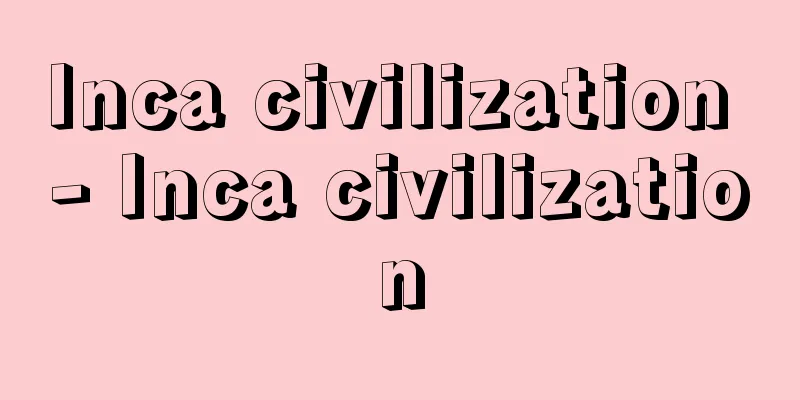Inca civilization - Inca civilization

|
A civilization that flourished in the Andes region of South America from the 13th to the mid-16th century. Grain farming was introduced to the Andes around 2000 BCE, and various cultures such as the Chavin, Mochica, Nazca, and Tiahuanaco emerged, with the Inca civilization being the pinnacle of this. It developed independently without contact with cultures on the Old World, but declined after being conquered by the Spanish in the 16th century. The Inca civilization was based on agriculture using large-scale irrigation facilities, and its crops included corn, potatoes, pumpkins, tomatoes, peanuts, coca, and cotton, many of which were unknown to Europe. The Inca Empire excelled in political organization and social systems, but did not excel in the fields of scientific learning. However, it reached a high level of architecture and civil engineering, and produced magnificent stone buildings and road networks based on well-organized urban planning. The temples of the sun scattered throughout the country, the fortress of Sacsawaman (see Sacsawaman Ruins), which is said to have been built by 20,000 to 30,000 people every day for 80 years, and the ingenious irrigation channels with their long traditions are the culmination of Inca architectural techniques. They also excelled in craftsmanship, leaving behind many excellent pieces of gold, silver, and copper work, pottery, and textiles. However, their designs were mostly standardized geometric patterns and lacked artistic originality. Surgery and pharmacology were also developed, and cranial drilling was performed using the anesthetic coca. The Inca religion was animistic, with gods such as the sun, moon, stars, thunder, earth, and sea reigning under the creator god Viracocha, and they had a particularly strong belief in the sun god. The purpose of their faith was to harvest crops and treat illnesses, and they did not have a culture like the Maya civilization. Although a systematic writing system was never invented, a knotty alphabet (quipu) was invented as a substitute, and numbers were recorded in a decimal system and used for official statistics. (→Andean civilization) Source: Encyclopaedia Britannica Concise Encyclopedia About Encyclopaedia Britannica Concise Encyclopedia Information |
|
13~16世紀中葉に南アメリカ,アンデス地方に栄えた文明。アンデス地方には前2000年頃から穀物農耕が伝わり,チャビン文化,モチーカ文化,ナスカ文化,ティアワナコ文化など諸文化が興ったが,インカ文明はその頂点をなす。旧大陸の文化と接触をもたず,独自の発展を遂げたが,16世紀にスペイン人に征服されて衰退した。インカ文明は大規模な灌漑施設による農業を基礎とし,その作物にはトウモロコシ,芋類,カボチャ,トマト,ラッカセイ,コカ,綿花などがありヨーロッパに未知なものが多かった。インカ帝国は政治組織,社会制度では卓越していたが,科学的学問の分野ではふるわなかった。ただし,建築,土木技術の面では高度の水準に達し,整然たる都市計画に基づく壮大な石造建築物や道路網が生まれた。各地に散在する太陽の神殿,80年間に毎日 2~3万人を動員して築いたといわれるサクサワマンの城塞(→サクサワマン遺跡),長い伝統をもつ巧みな灌漑水路などは,インカ建築技術の粋を集めたものといえる。工芸技術にも秀で,金銀銅細工,土器,織物などに優れたものを多数残している。しかし,意匠はおもに幾何学模様で規格化され,芸術的独創性に乏しかった。外科手術や薬学も発達し,麻酔剤コカを用いての頭蓋穿孔が行なわれた。インカの宗教は創造神ビラコチャのもとに太陽,月,星,雷,大地,海などの神々が君臨するアニミズムで,特に太陽神信仰が強かった。信仰の目的は,農作物収穫と病気の治療にあり,マヤ文明のような文化はみられなかった。系統的な文字はついに発明されなかったが,これに代わるものとして結縄文字(キープ)が案出され,数は十進法で記録されて,公の統計に用いられた。(→アンデス文明)
出典 ブリタニカ国際大百科事典 小項目事典ブリタニカ国際大百科事典 小項目事典について 情報 |
Recommend
Aiolia - Aioria
…Typhōn, the king of monsters who was struck by l...
Golden Head
...His later thoughts on the nature of poetry and...
Awafu - Awafu
… Namafu is an essential ingredient in kaiseki an...
Samarqand
…It lies in the Zarafshan River basin. It is also...
Czaczkes, SJ (English spelling)
…A contemporary Israeli Hebrew author. His real n...
Derris triforiata (English spelling) Derris triforiata
… [Mitsuru Hotta]... *Some of the terminology tha...
Arkas
…Thus, although Artemis was eventually added to t...
Red peeling - Akamuki
…These knots are then shaved with a knife to give...
"Strawberry White Paper"
...Furthermore, in the 1970s, the image of youth ...
Shinso - Foundation of the Heart
〘Noun〙 The foundation stone of the central pillar ...
Bakary, D.
...France took until 1921 to put down the fierce ...
Glacer/gracé (France)
1. In French cuisine, the dish is made shiny by bo...
Gravette culture
A culture that flourished during the Late Paleolit...
Chunan [town] - Chunan
A former town in Nakatado District, southern Kagaw...
Lapita
…The oldest pottery in Oceania, found in the sout...





![Sakuragawa [Village] - Sakuragawa](/upload/images/67cba991e6cc6.webp)



